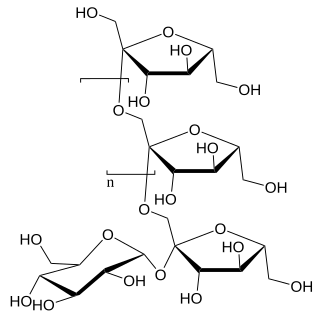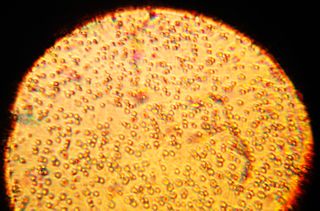This article needs additional citations for verification .(April 2011) |
Natural growth promoters (NGPs) are feed additives for farm animals.
This article needs additional citations for verification .(April 2011) |
Natural growth promoters (NGPs) are feed additives for farm animals.
Different categories of feed additives for farm animals are referred to as natural growth promoters (NGPs) or non-antibiotic growth promoters. They are commonly regarded as favorable alternatives to antibiotic growth promoters (AGPs) in livestock production.
NGPs include predominantly organic acids, probiotics, prebiotics, synbiotics, phytogenics, tannins, feed enzymes and immune stimulants., an ongoing search for alternatives has created a large variety of NGPs for pigs, poultry, ruminants and aquatic species.
The main advantage of NGPs over AGPs is that they do usually not bear any risk regarding bacterial resistance or undesired residues in animal products such as meat, milk or eggs. Addition of NGPs to feeds of farm animals may have a number of beneficial effects, including:
| - rapid development of a healthy gut microflora |
| - stabilization of digestion |
| - increased growth performance |
| - stimulation and rapid maturation of the immune system |
| - reduced incidence of diarrhea |
| - improved feed efficiency |
| - lower mortality rates |
| - higher profitability [ citation needed ] |
Acidifiers, such as organic acids or their salts, are used to prevent microbial degradation of raw materials or finished feeds, especially under poor storage conditions (e.g. high moisture content, high levels of contamination with molds). Moreover, acidifiers may improve growth performance through establishment of low gastrointestinal pH conditions which support endogenous digestive enzymes and reduce undesired gut microorganisms. Many dietary acidifiers are based on propionic acid, formic acid, lactic acid and others, either as single components or in combination. Some acidifiers also contain inorganic acids (e.g. phosphoric acid).
Probiotics are live microorganisms or viable spores which support the development of a beneficial gut microflora. Probiotic bacteria (e.g. from the genera Lactobacillus, Bifidobacterium, Enterococcus) counteract undesired microorganisms such as Salmonella or E. coli by blocking receptors on the gut wall, production of antimicrobial substances or activation of the immune system.
Prebiotics are carbohydrates which are indigestible for the host animal. On the other hand, they are selectively fermented by beneficial gut bacteria and, therefore, support a healthy gut microflora. These include fructose oligosaccharides (FOS) including inulin, transgalactose oligosaccharides (GOS), xylooligosaccharides (XOS) and soy oligosaccharides such as stachyose, verbose and raffinose. Mannan oligosaccharides are sometimes included as prebiotics but are not fermentable. This was confirmed by Smiricky-Tjardes et al. at the University of Illinois [1] and so might be more appropriately termed immunosaccharides since they act as decoys for pathogen attachment (Salmonella and E. Coli) and result in increased immunoglobulins (IgAs) at intestinal level.
Combined administration of probiotics and prebiotics, referred to as synbiotics, is supposed to cause synergistic effects in terms of gut health and performance.
Phytogenics are derived from herbs, spices or aromatic plants and have shown antimicrobial, antifungal, antiviral, antioxidant or sedative properties. They are known for their appetizing effects, since they increase the palatability of the feed and stimulate endogenous digestive enzymes. Moreover, phytogenics have a pronounced impact on the gut microflora. [2]
Tannins are polyphenolic compounds produced by plants, ranging in concentrations from <2% to more than 20% of dry weight and may protect plants from herbivore, increase resistance against pathogens, or protect tissues such as wood against decay. [3] In-vitro and in-vivo results suggest that two of the most abundant and common source of tannins, chestnut (Castanea sativa; hydrolyzable tannins) and quebracho (Schinopsis lorentzii, condensed tannins) extracts, are effective to reduce and control infection. [4] [5] Moreover are considered a natural alternative to AGPs due to the difficulty of bacteria to develop resistance against the diverse range of molecules that contain these plant compounds. [6]
Animal feeds contain varying levels of indigestible nutrients and undesired components such as fiber, phytate or proteins with antigenic effects. Different feed enzymes such as, carbohydrases, phytases or proteases, can be included in feeds to improve the use of energy and nutrients or to degrade several undesired components. Moreover, some enzymes (e.g. amylases, lipases) can be added to the feed of young animals in order to support the endogenous enzyme secretions.
Different feed additives may function as stimulator or modulator of immunity processes. Specific cell wall fragments from bacteria or yeasts or sea algae may induce activation of immune cells (e.g. macrophages, lymphocytes).
Biotics describe living or once living components of a community; for example organisms, such as animals and plants.

Lactobacillus is a genus of gram-positive, aerotolerant anaerobes or microaerophilic, rod-shaped, non-spore-forming bacteria. Until 2020, the genus Lactobacillus comprised over 260 phylogenetically, ecologically, and metabolically diverse species; a taxonomic revision of the genus assigned lactobacilli to 25 genera.

Butyric acid, also known under the systematic name butanoic acid, is a straight-chain alkyl carboxylic acid with the chemical formula CH3CH2CH2CO2H. It is an oily, colorless liquid with an unpleasant odor. Isobutyric acid is an isomer. Salts and esters of butyric acid are known as butyrates or butanoates. The acid does not occur widely in nature, but its esters are widespread. It is a common industrial chemical and an important component in the mammalian gut.
An oligosaccharide is a saccharide polymer containing a small number of monosaccharides. Oligosaccharides can have many functions including cell recognition and cell adhesion.

Lactobacillus acidophilus is a rod-shaped, Gram-positive, homofermentative, anaerobic microbe first isolated from infant feces in the year 1900. The species is most commonly found in humans, specifically the gastrointestinal tract, oral cavity, and vagina, as well as various fermented foods such as fermented milk or yogurt. The species most readily grows at low pH levels, and has an optimum growth temperature of 37 °C. Certain strains of L. acidophilus show strong probiotic effects, and are commercially used in dairy production. The genome of L. acidophilus has been sequenced.

Fructooligosaccharides (FOS) also sometimes called oligofructose or oligofructan, are oligosaccharide fructans, used as an alternative sweetener. FOS exhibits sweetness levels between 30 and 50 percent of sugar in commercially prepared syrups. It occurs naturally, and its commercial use emerged in the 1980s in response to demand for healthier and calorie-reduced foods.
Prebiotics are compounds in food that foster growth or activity of beneficial microorganisms such as bacteria and fungi. The most common environment considered is the gastrointestinal tract, where prebiotics can alter the composition of organisms in the gut microbiome.

Raffinose is a trisaccharide composed of galactose, glucose, and fructose. It can be found in beans, cabbage, brussels sprouts, broccoli, asparagus, other vegetables, and whole grains. Raffinose can be hydrolyzed to D-galactose and sucrose by the enzyme α-galactosidase (α-GAL), an enzyme which in the lumen of the human digestive tract is only produced by bacteria in the large intestine. α-GAL also hydrolyzes other α-galactosides such as stachyose, verbascose, and galactinol, if present. The enzyme does not cleave β-linked galactose, as in lactose.

Gut microbiota, gut microbiome, or gut flora, are the microorganisms, including bacteria, archaea, fungi, and viruses, that live in the digestive tracts of animals. The gastrointestinal metagenome is the aggregate of all the genomes of the gut microbiota. The gut is the main location of the human microbiome. The gut microbiota has broad impacts, including effects on colonization, resistance to pathogens, maintaining the intestinal epithelium, metabolizing dietary and pharmaceutical compounds, controlling immune function, and even behavior through the gut–brain axis.
Phytogenics are a group of natural growth promoters or non-antibiotic growth promoters used as feed additives, derived from herbs, spices or other plants. The term phytogenic feed additives was coined by an Austrian multinational feed additives company named Delacon, and was first introduced to the market in the 1980s.
A Prebiotic Score, also known as Prebiotic Activity Score, is a term sometimes used to estimate the health effects of prebiotics in humans or animals. The idea is that although prebiotics may have many different effects in the human gut, some of these may be quantified and combined to an overall score. For example, an increase in the populations of bifidobacteria or lactobacilli coincides with a relative increase in prebiotic activity; accordingly, an increase in enteric bacteria strains such as Clostridium perfringens result in a decrease of prebiotic activity. Also, increases and reductions of certain enzymes may be used as factors in a prebiotic score.
Levilactobacillus brevis is a gram-positive, rod shaped species of lactic acid bacteria which is heterofermentative, creating CO2, lactic acid and acetic acid or ethanol during fermentation. L. brevis is the type species of the genus Levilactobacillus (previously L. brevis group), which comprises 24 species. It can be found in many different environments, such as fermented foods, and as normal microbiota. L. brevis is found in food such as sauerkraut and pickles. It is also one of the most common causes of beer spoilage. Ingestion has been shown to improve human immune function, and it has been patented several times. Normal gut microbiota L. brevis is found in human intestines, vagina, and feces.
Limosilactobacillus fermentum is a Gram-positive species in the heterofermentative genus Limosilactobacillus. It is associated with active dental caries lesions. It is also commonly found in fermenting animal and plant material including sourdough and cocoa fermentation. A few strains are considered probiotic or "friendly" bacteria in animals and at least one strain has been applied to treat urogenital infections in women. Some strains of lactobacilli formerly mistakenly classified as L. fermentum have since been reclassified as Limosilactobacillus reuteri. Commercialized strains of L. fermentum used as probiotics include PCC, ME-3 and CECT5716

Galactooligosaccharides (GOS), also known as oligogalactosyllactose, oligogalactose, oligolactose or transgalactooligosaccharides (TOS), belong to the group of prebiotics. Prebiotics are defined as non-digestible food ingredients that beneficially affect the host by stimulating the growth and/or activity of beneficial bacteria in the colon. GOS occurs in commercially available products such as food for both infants and adults.

Pediococcus acidilactici is a species of Gram-positive cocci that is often found in pairs or tetrads. P. acidilactici is a homofermentative bacterium that can grow in a wide range of pH, temperature, and osmotic pressure, therefore being able to colonize the digestive tract. It has emerged as a potential probiotic that has shown promising results in animal and human experiments, though some of the results are limited. They are commonly found in fermented vegetables, fermented dairy products, and meat.

Bifidobacterium is a genus of gram-positive, nonmotile, often branched anaerobic bacteria. They are ubiquitous inhabitants of the gastrointestinal tract though strains have been isolated from the vagina and mouth of mammals, including humans. Bifidobacteria are one of the major genera of bacteria that make up the gastrointestinal tract microbiota in mammals. Some bifidobacteria are used as probiotics.
Isomaltooligosaccharide (IMO) is a mixture of short-chain carbohydrates which has a digestion-resistant property. IMO is found naturally in some foods, as well as being manufactured commercially. The raw material used for manufacturing IMO is starch, which is enzymatically converted into a mixture of isomaltooligosaccharides.

The human milk microbiota, also known as human milk probiotics (HMP), refers to the microbiota (community of microorganisms) residing in the human mammary glands and breast milk. Human breast milk has been traditionally assumed to be sterile, but more recently both microbial culture and culture-independent techniques have confirmed that human milk contains diverse communities of bacteria which are distinct from other microbial communities inhabiting the human body.
Nutritional immunology is a field of immunology that focuses on studying the influence of nutrition on the immune system and its protective functions. Part of nutritional immunology involves studying the possible effects of diet on the prevention and management on developing autoimmune diseases, chronic diseases, allergy, cancer and infectious diseases. Other related topics of nutritional immunology are: malnutrition, malabsorption and nutritional metabolic disorders including the determination of their immune products.

Kestose is a class of sugars that belongs to a group of fructooligosaccharides.
This Article